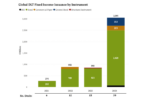This is a guest opinion post from Mark Smith, CEO of Symbiont.
As we reflect on 2021 and how early adopters of enterprise blockchain technology have benefited from the efficiencies generated by novel technologies, we feel optimistic about the future of the blockchain industry, particularly within capital markets and financial services.
It’s becoming increasingly clear that blockchain can significantly reduce risk in a way that impacts the bottom line. There are a range of capital market applications we have tested and see a growing appetite and many opportunities in solving back-office OTC, OTC, securities, and index data challenges. Furthermore, we believe that leading financial institutions will look to blockchain as the solution of choice in the area of green energy.
In 2021 we saw massive projects come to life, including some of our own key initiatives with our Smart Collateral application, in which we demonstrated the potential of blockchain to cut counterparty exposure by approximately 80% in the FX forward currency market in comparison to current convention. Asset managers such as Vanguard and custodians such as State Street have been blockchain champions in the industry and through our collaboration, we have driven the evolution of the industry in FX into a new realm.
Eliminating reconciliation problems inherent in data applications is another key area of opportunity for enterprise blockchain. We firmly believe that the role blockchain can play in data will become clearer in 2022. Patterns have begun to emerge for how to integrate blockchain with existing data solutions to improve overall data quality and provide more value to end-users of data.
Overall, our prediction for next year is that blockchain technology within institutional finance will play a critical role in improving speed, efficiency and transparency while correcting complex financial market infrastructure problems.
In the early 2000’s we saw technological innovation take off within capital markets, but it was limited to the front office. Until now, technological innovation in the back office has been ignored and neglected. Smart contracts are the applications of the next generation to solve financial market infrastructure problems. Like we proved at the end of this year with our partners, blockchain technology will be the technology of choice to modernize operations as more financial institutions look to optimize inefficient costly processes and the outdated applications that support them.
When a blockchain is used as the system of record for financial instruments, a smart contract will do more than just improve operational workflows; it will transition traditional financial markets onto a digital infrastructure shared by all market participants. Blockchain technology enables financial instruments to suddenly take a digital form for the first time.
Lastly, as ESG continues to grow, we predict that the early enterprise blockchain adopters will also see the benefits of using the technology to solve problems within novel marketplaces. This innovative tech can easily solve environmental, social and governance problems currently being experienced. There currently isn’t an efficient platform for solving green energy projects and we believe blockchain can dramatically reduce the time in contract negotiations while lowering transaction costs.
A smart contract is a “contract” that governs the behavior of computers instead of people and organizations. And a blockchain, by virtue of being an internally consistent, decentralized system, can serve as a platform on which stateful decentralized applications, such as smart contracts, can run. With blockchain technology, financial instruments can be objects in the smart contracts.
At Symbiont, with our Assembly blockchain platform, we are using smart contracts to model the complex business logic and multi-party workflows of traditional financial instruments that may themselves live wholly on a blockchain network. In conclusion, we firmly believe widespread adoption of blockchain will continue to dramatically increase in 2022.






